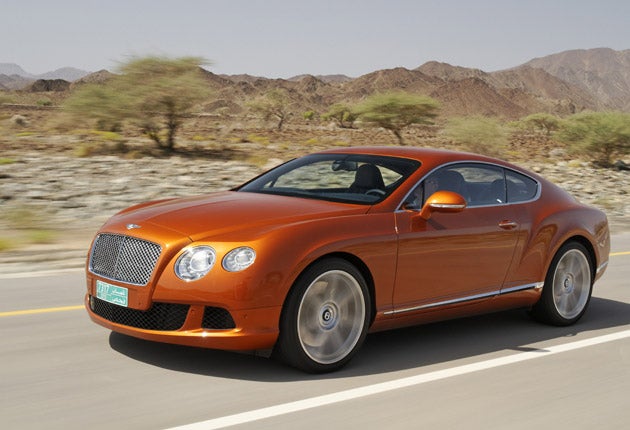Bentley Continental GT
Dismissed as a flashy 'footballer's car' in the past, the refurbished Bentley is wonderfully indulgent

Which came first: the car or the image? Bentley's Continental GT is readily dismissed by the cynical as a "footballers' car".
It is true that the model has proved popular around Alderley Edge, but that was not its raison d'être. It was instead created as a way of expanding the Bentley brand after its separation from Rolls-Royce, and in that quest it has certainly succeeded.
The GT's launch happened eight years ago, although it seems more recent. Eight years is a long time in the modern motor industry, where development times are compressed far beyond past recognition and all car-makers are desperate to keep their customers' attention. Especially when they are as wealthy as those who kick a ball around for a living. So now there is a new Continental GT.
The overall shape has changed little but the edges are sharper and the front grille thrusts forward more assertively. The wheels are bigger and are set laterally further apart from each other. Inside, too, the look is edgier, and there's a new stereo and sat-nav system able to store 30GB of music files and show Google maps.
Look more closely and you'll notice the backs of the front seats are a little thinner, which makes the rear seat usefully more roomy. They are slimmer because they no longer carry the whole seatbelt mechanisms and their attendant strengthening, the belts instead now offered by a retractable arm from behind your shoulder, Mercedes-coupé-fashion. This new GT weighs 65kg less than the old one, a welcome reversal of the usual new-car trend and evidence that car-makers are starting to take vital weight loss seriously.
All that said, 2,320kg is still a hefty lump of car. Just as well, then, that it has a 6.0-litre, W12 engine – effectively two narrow-V6s sharing a common crankshaft – to haul it. With the help of two turbochargers, the W12 produces 575bhp (up by 15bhp from the old car), plus an admirable 516lb/ft of torque available at just 1,700rpm.
But are not all these just incremental improvements, just a new layer of icing on an already rich, luxurious, expensive cake? Yes, but underpinning them all is a new version of the four-wheel drive system which now sends 60 per cent of the engine's efforts to the rear wheels and 40 per cent to the front, instead of equal amounts to all four.
This simple change dramatically alters how the Bentley feels. Always very fast, it used to feel nose-heavy, unwieldy, a bit stolid. For a car intended to have a sporting flavour, this was not ideal. Some rapid runs along sweeping roads in the Oman desert, revealed a personality transformed. Now the GT hides its mass well, turning keenly into fast corners and then sticking firmly to your chosen line.
More power in a bend now allows the beginning of the very gentle tail-drift usual in a powerful rear-wheel drive car, and it makes the Bentley feel properly sporting. The engine storms from a standstill to 62mph in 4.6 seconds and on, if allowed, to 198mph. No wonder 384g of CO2 (at least) pour forth every kilometre.
Only under hard braking does the weight reveal itself. Keen drivers might like the carbon-ceramic brakes option, a cool £10,000 on top of the car's £135,760 base price, but they can't do much about an engine note boomier and less melodious than a 12-cylinder engine's should be. Nor should they be feeling the engine vibration through the steering wheel; instead they should feel the tyres working against the road, which they can't because there's too much anaesthesia in the system despite its new-found precision.
All that said, the new Continental GT is wonderfully indulgent. Its wood and leather are as exquisite as ever, and I know of no car with a lovelier oil filler cap than the GT's machined aluminium item. In a year's time there will be a new 4.0-litre V8 engine, much more frugal (helped by an eight-speed gearbox) and probably more mellifluous. Cheaper, too, perhaps. That will be the one to have.
The Rivals
Aston Martin DB9: £116,950
Built to Bentley standards, lighter aluminium chassis. Its 5.9-litre V12 offers 470bhp; suspension changes greatly improve ride and handling.
Ferrari 612 Scaglietti: £217,230
Biggest, bulkiest Ferrari. Not everyone's idea of beauty but 532bhp V12 sounds magnificent. All-aluminium body and chassis, enormous price.
Maserati GranTurismo S Automatic: £86,220
Near-bargain, with striking styling and a 4.7-litre, 433bhp V8. Much more satisfying than non-S version thanks to more engine torque.
Join our commenting forum
Join thought-provoking conversations, follow other Independent readers and see their replies
Comments